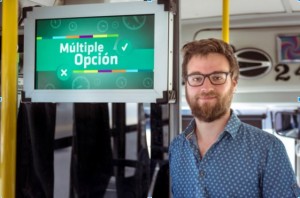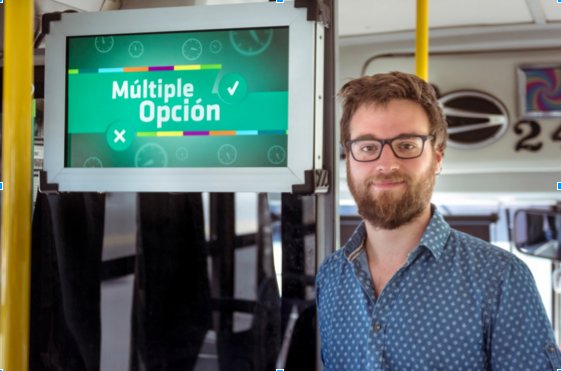Másbus − an experience to bring more to the commuters’ day than just getting from A to B
+bus (pronounced: *Más bus*, meaning: *plus bus*) makes more of the riding experience on buses in Montevideo. Through digital signage it nurtures the commuting community of Uruguay’s capital with valuable and positive information every day.
Since 2014 +bus has installed about 100 screens on 10 regular bus lines in the metropolitan area of Montevideo where roughly 750,000 people commute daily. In a month, 4 million people are reached.
What makes +bus unique is its mission to inform people with cheerful community related topics, creating a sense of belonging and optimism among people. Ever since this initiative has started, passengers, drivers and particularly ticketers report the atmosphere to be more relaxed and joyful.

OnSign TV: Was there no digital signage in Uruguay before?
+bus: There have been two public transportation initiatives with digital signage in the past, each ten years apart. The first one actually were TVs with VHS. There was commercial interest in placing advertisement, but they were expensive to run, the quality wasn’t there yet and at the same time an economic depression started.
Almost ten years after that, and pretty much the same time we were starting, a company made another attempt in a similar way, yet they had a digital system. That project lasted less than a year because it didn’t have user oriented content.
We learned a lot from those projects. They did a lot right and where they failed is where we to innovated and thought outside the box. Because really, the core business of any signage project is content. Even though from a commercial standpoint it’s very important to have advertising much if not most of the time. That’s where the revenue comes from. But, if people aren’t really interested, they’re not gonna look at anything on the screen and everything that is there loses its value.
OnSign TV: Content at the center of digital signage seems logical. How did the focus come on community topics.
+bus: We knew we needed a solid communication platform. We thought of the whole network from the audience’s perspective in order to have an effect and for the people to be really engaged and watch the screen on their buses.
Public transportation is different from private ownership. The screens are installed in a public place. Whatever is going to be played on them belongs to the public as well. We wanted to play with that feeling of belonging to the community. We only show content that is going to make your day better. Commuting is tiring. Our idea is that you as the passenger get off the bus with a gain, something you have learned, made you laugh or made you strike a conversation with someone sitting right next to you and get to know each other.
The people who work and use the public transportation, especially the bus ticket officers who probably have the best viewpoint on that matter, have noticed that after we installed the screens people are more relaxed and easy going where in the past they were stressed. That’s the reason why we’re in this, to make a difference − and of course − to make a profitable business, to innovate, to develop because that’s what we love. Most of all, we’re in this to actually give and to make theirs and our home better.
OnSign TV: How did you walk the initial steps?
+bus: Three of my associates had this core idea, but actually making it come true took a lot of hard work. A digital signage network on public transportation comes with challenges that you will not find in any other digital signage project, only in public transportation.
It took about 3 years of planning and development. We needed permission from the authorities. We also needed to get the public transportation companies on board who were at first not very convinced as they have had experiences with it in the past. We showed them the difference and seeing the potential, not only from a commercial standpoint, and they all came aboard. I think it was August 2014 when the first screen on the first bus was installed and we haven’t stop since. By the last quarter of 2015, we had installed up to 90 and we just keep adding to it.
OnSign TV: Does every bus of a single line have screens?
+bus: Unfortunately, some have and some don’t, that’s the nature of the public transportation system here. In Europe or the United States there is mostly one company or it’s state driven, thus most buses are exactly the same or follow a line of models. Here in Uruguay, we have 4 or 5 different companies providing the public transportation system and they all have 10 different types of buses. Some of them were really old, 25 years old. We couldn’t install in all of them even if we wanted to. Fortunately, right now there’s a big recycling wave and new buses are coming to the city which have been impactful.
It’s more complicated even since all the buses serve any line. One day they’re on one line and on another the next.
OnSign TV: That’s interesting from the digital platform perspective because there is content related to each bus line or route.
+bus: That was one of the things we wanted to do at first but we don’t have the ability to define which buses are serving which line each day. For now, we have segmented content per bus company. But we already have this specific project we talked to you. For the reference campaign OnSign develops this trigger function where campaigns are played according to GPS location.
OnSign TV: Indeed, this is something fairly new. There are now two different ways you can use the GPS. One is to add the campaign to an area the usual way. The new one triggers the campaign once a street or a specific point is crossed.
+bus: We’re definitely going to use that. As we don’t have control over the bus lines to segment the geographical sites, this tailor fits our needs. We have such a good relationship with OnSign. You listen to what we need. Then, after a couple of weeks or months we’ll get a call: “This is what you wanted – you have it.”
OnSign TV: Speaking of relationship, why did you choose OnSign TV as your Digital Signage Platform?
+bus: That’s exactly one of the reasons why we’re so invested in your company. When you have a project like ours and you’re not the software developer, you rent the software from somewhere. A software may be really good and you may have a thousand of guys coding all day making it better, but it’s actually from the standpoint of the provider.
We always say that we have a very special bond with OnSign and everybody who works there. Aside from always being willing to hear what we want to say and welcoming to take different approaches, you were always there when we needed it. Aside from the software being really good, it’s one of the best software engineering − and I have lots of experience in that. It’s the people behind it that really make it work and make it great.
OnSign TV: One of the things other people might be interested in is the learning curve you guys have been through. What kind of mistakes did you make which you learned from the most?
+bus: This is crucial and probably one of the most important aspects of our business. “Failing is not negative, failing is always an opportunity.”
We’ve had our fair share of opportunity that came from failure that actually made us better. It is a normal part of the process of research and development. There’s a word we often use: iteration. We never do something big scale before we have three or four iterations on it because in business failure has a price. It is an opportunity, but it has a price. We like to start small.
One area we failed at first which today is a big success was the hardware. We had to make an important decision. Interestingly, at most three or four years ago, when we started looking for our hardware platform the world of digital signage was saying no to Android. Everyone said it was not going anywhere and not reliable enough. The companies developing Android devices are not actually thinking reliability. They think about mass business you can use and change. That’s something not compatible with industrial grade which has to be ready 24/7.
Because of cost and in a way because we wanted to, feeling there had to be a better option than buying a $1,700 computer for a bus, we actually opted to go for Android anyway. That turned out to be a good bet. Android in those years − and Android-based hardware and software for digital signage − has evolved so drastically that if you go to any expo today, all the big companies that said no to Android are actually selling Android like it’s the new thing when in reality it’s not that new.
Read more about the technical aspect of digital signage +bus worked their way through in a special hardware piece on public transportation. Write us at info@onsign.tv to subscribe to our newsletter.
Coming full circle, research and development is a key for our project, along with content and a solid commercial strategy. That’s where we like to share our experience with other projects around the world, where we could give value.
OnSign TV: Ideologically, I really enjoy how resourceful you are and how in a way democratic. Your progress now will make it accessible for other places somewhere else. You definitely have a lot to share.
Edgar, thank you for talking about the challenges you encountered and how you solved them. We covered the technical part above else, but are already looking forward to hearing more about the content and business part in a following interview. After all, the biggest group in your team is the marketing and communication department. It’s where the connecting content comes from.
We find your mission inspiring and are honored to be a partner in it as your digital signage management platform.
Connect directly to +bus or Edgar Blumenfeld on Linkedin and view +bus on Youtube.







